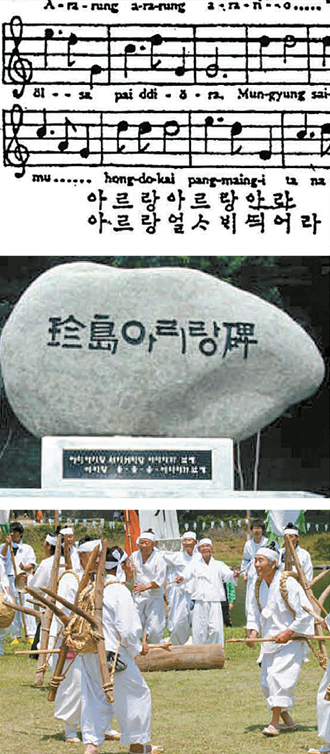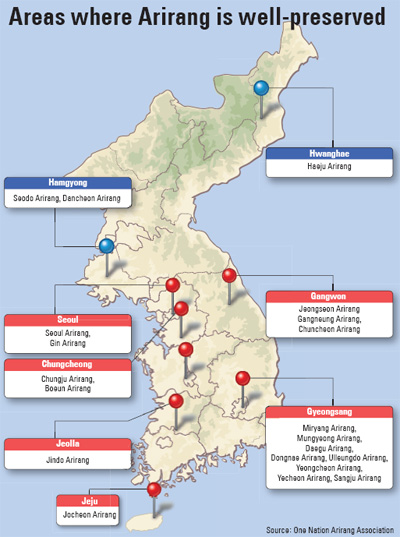What’s the best way to sing Korea’s song?

The city of Jeongseon held a celebratory performance in addition to putting up congratulatory banners across the country. [JoongAng Ilbo]
Now it’s time for some “Arirang” style - or at least, that is the hope of Korean policy makers.
Korea’s traditional folk song “Arirang” was added to Unesco’s intangible cultural heritage list earlier this month. And with this, Korean policy makers have rolled up their sleeves to better promote the song to the international audience and market.

Top: The score for the original version of “Mungyeong Arirang,” written in 1896 Middle: A monument dedicated to “Jindo Arirang” Above: Miryang, which holds an “Arirang” festival every spring, plans to establish a preservation society for the song. Source: respective organizers, [JoongAng Ilbo]
According to the Ministry of Culture, Sports and Tourism, there are at least 60 versions of “Arirang” and 4,000 songs of “Arirang” across the Korean Peninsula. Most of them contain the refrain, “arirang, arirang, arariyo.” And it’s that versatility and ability to transform and accommodate that got the song noticed by Unesco.
“Everyone can create new lyrics, adding to the song’s regional, historical and genre variations, and cultural diversity,” Unesco said in a press release, after its Intergovernmental Committee for the Safeguarding of the Intangible Cultural Heritage decided to inscribe the song on the heritage list during its seventh meeting on Dec. 5 at Unesco headquarters in Paris.
However, “Arirang” being in many versions and many forms in different regions and districts also means that there are many people and entities that claim the rights to “Arirang” as well as many ideas and voices on how best to promote and market the song.
Local governments are working to build a museum, a research center and hold an international festival to commemorate the song - which some liken to another name for Koreans or a second national anthem.
But critics argue that rather than expending efforts to implement policies and decisions that are mere displays and show-offs, it’s important to come up with marketing ideas that will appeal to foreigners with no knowledge of Korean history and traditions, for instance associating with musicals, film or K-pop.

Mungyeong in North Gyeongsang is one of the most active and quickest in “Arirang marketing.”
Among others, it is working to build a museum dedicated entirely to “Arirang.” Its plan is to build a museum equipped with performing stages - big and small - exhibition halls, storage rooms and an education center in the 3,584-square-meter (38,577-square-foot) city property at the entrance of Mungyeongsaejae, the historic and famous mountain pass in the city. The city has earmarked 120 billion won ($111.63 million) for the envisioned facilities.
“There is an increased number of foreigners hoping to learn about ‘Arirang’ - which is promoted to embody the quintessential Korean spirit,” Ko Yun-hwan, the mayor of Mungyeong, explained what prompted the city government to come up with the idea for a museum. “But there are no facilities where foreigners can experience ‘Arirang’ at a glance - see related materials, enjoy performances and so on.”
Meanwhile, Jeongseon in Gangwon, where large banners hailing the inscription of “Arirang” on Unesco list can be found across the city, is also envisioning similar facilities.
The people of Jeongseon have a special place in their hearts for “Arirang,” with many of them believing that the song originated there. So much so that in fact, the city of Jeongseon and the central government have previously unsuccessfully attempted to add “Jeongseon Arirang” to the Unesco list in 2009.
Today the city of Jeongseon is working to build a culture center for “Arirang,” which would include a 612-seat performing stage, and for that it has set aside some 28 billion won. In addition, the city also plans to establish a state-run research center for the song.
The 2018 Winter Olympics, which will be held between Feb. 9-25, 2018 in nearby Pyeongchang - also in Gangwon and about an hour drive from Jeongseon - is a good chance to promote the “Jeongseon Arirang” to the world. In fact, the city of Jeongseon is working to perform “Jeongseon Arirang” at the opening and closing ceremonies of the event.
Miryang and Jindo are also hopping on the bandwagon.
Miryang, which holds its annual Miryang Arirang Festival between April and May, is working to set up an organization tasked with the preservation of “Arirang,” while Jindo has held a conference on Dec. 21 on ways to promote “Jindo Arirang” to the world.
Critics express concerns about such competitive “Arirang” marketing by the country’s local governments.
“Local governments should stay away from ideas that put a focus on external performances,” said Jin Yong-seon, the head of the Jeongseon Arirang Research Institute.
“Instead, they should work on developing ideas that are solid and sustainable.”
Jin points out that although “Arirang” appeals to Koreans, it in itself lacks that sort of instant appeal to foreigners, so it’s important to collaborate with other forms of art like opera, musical, film, dance or K-pop and develop new, more relatable content.
Kim Yeon-gap, who studied “Arirang” for a long time and recently published a book called “The Culture of Arirang” pointed to the use of the song for re-creation in music.
“Already there are some 70 pop songs that took ‘Arirang’ as its motif,” Kim said. “Yet even today K-pop continues to introduce new versions of ‘Arirang.’?”
Kim adds city governments should develop programs that put a focus on the song’s ability to adapt and communicate as that would be key to the globalization efforts of “Arirang.”
Who’s original?
In the meantime, the debate continues over which “Arirang” is the original version. Historians say the reason for the existence of thousands of “Arirang” across the country has to do with the restoration process of Gyeongbok Palace during the reign of Heungseon Daewongun (1820-1898) in the 1860s.
Laborers from all over the peninsula gathered and they vented their hardship, sorrow and homesickness on the melodies of “Arirang.” As they went back to their hometowns, the songs were passed down the generations, slightly modified over time.
It’s true that many experts consider “Jeongseon Arirang” the oldest, with some scholars even arguing that its origin dates back to the early Goryeo era (918-1392). They base this theory on the fact that the difference between the lowest note in “Jeongseon Arirang” and the highest note is the smallest at just seven notes. In the case of “Miryang Arirang,” it’s 11 notes.
“?‘Jeongseong Arirang’ is the oldest in terms of form,” Kim Yeong-gap said. “The fact that the difference between the highest and lowest note is small means that it was sang by anyone easily in everyday life.”
However, opponents argue that just because “Jeongseon Arirang” is the oldest doesn’t mean that’s where other versions of “Arirang” originated from. They have a point because “Miryang Arirang,” “Jindo Arirang,” and “Bonjo Arirang” (from Seoul) have quite noticeably different tunes from “Jeongseon Arirang,” so it’s hard to say they derived from the same place.
The city of Mungyeong also points to lyrics: saying that “arirang gogae” - which means “arirang hill” or “arirang pass” - refers to the Mungyeongsaejae which was the gateway from the Gyeongsang region to capital Seoul.
Based on that, the city argues that the most-sang “Arirang” among the laborers at the Gyeongbok restoration was “Mungyeong Arirang” and it is also the most-spread “Arirang” when they went back to their homes, as the phrase “arirang gogae” appears in many versions of the song.
The city of Mungyeong also refutes the idea that Jeongseon is the “father of all Arirang” with the first Western-style music score of “Arirang” that adopts the lyrics of “Mungyeong Arirang.” The score is in a book published by Homer Hulbert (1863-1949), an American missionary in Korea who was also the foreign affairs adviser to King Gojong (1852-1919).
However, those who learned to sing “Jindo Arirang” refute both arguments of the supporters of “Mungyeong Arirang” and “Jeongseon Arirang.”
“Arirang gogae refers to Mungyeong Sejae [three hills], not Mungyeongsaejae,” said Song Hyeon, the head of Korean Music Research Institute he created in 1993. The former, Song says, refers to three mountain passes near the old city gate of Jindo.
This argument is also backed by the Preservation Society for Jindo Arirang. “According to our data, the lyrics of arirang passed down to ten gugak [traditional Korean music] performers in 1980s also had Mungyeong Sejae, not Mungyeongsaejae.”
As little is known about the exact origin and history of “Arirang” despite being with the Korean people for as long as they can remember, studies and debates look to be here to stay.
“The lyrics and melody of traditional Korean folk songs have an open structure, so everyone can create new variations befitting their own tastes,” said Kim Yeoung-wun, a traditional Korean music professor at Hanyang University. “?‘Arirang,’ therefore, came to have so many variations while being sung for centuries.”
By Song Yee-ho, Kim Hyung-eun [hkim@joongang.co.kr]










with the Korea JoongAng Daily
To write comments, please log in to one of the accounts.
Standards Board Policy (0/250자)